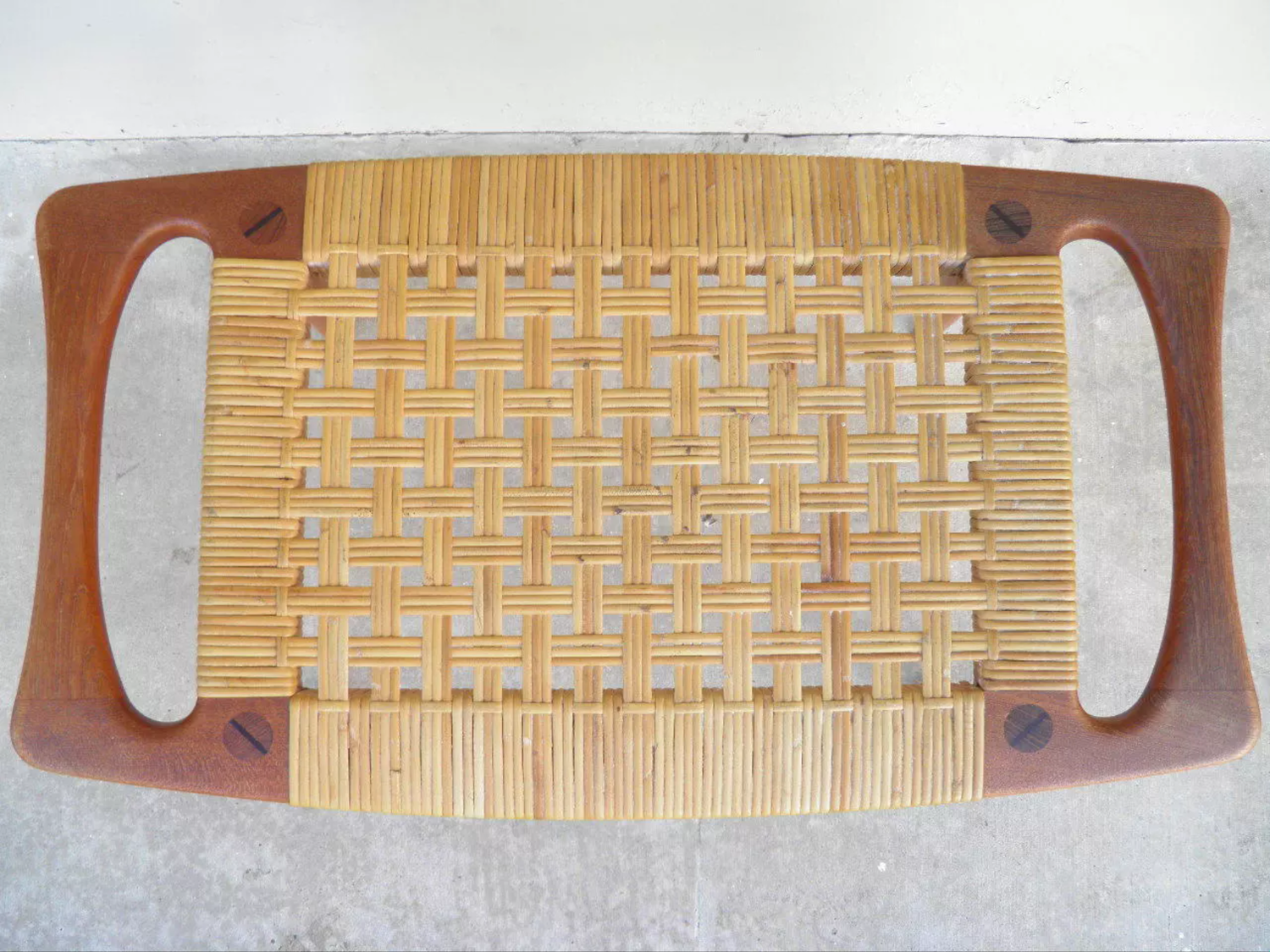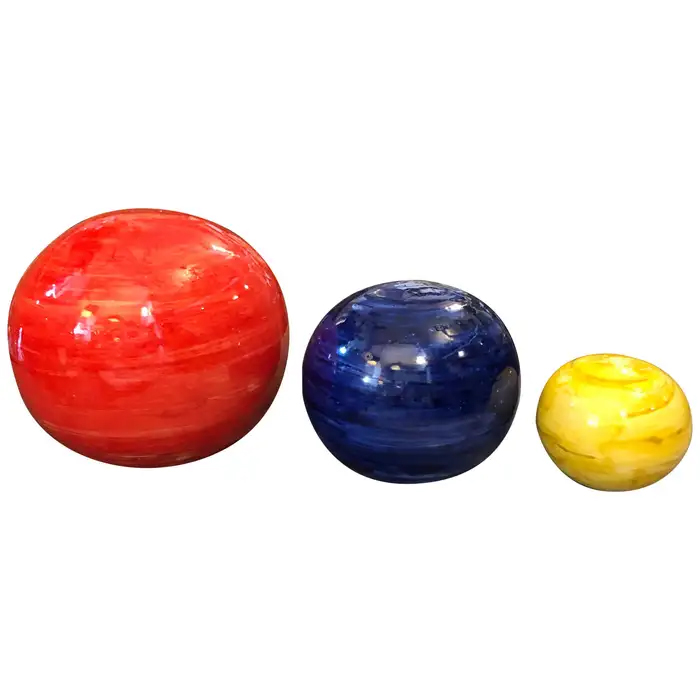Hello,
I acquired two years ago this stool from a Bruun Rasmussen auction , in order to match it with my Papa Bear Chair. There is a damaged sticker underneath from L. Chr. Larsen & Søn, I understand this cabinet was a subcontractor of Wegner furniture for number of Danish makers when they could not fullfil orders themselves, due to high demand.
I have no doubt about quality or authenticity, but i would really like to know more about this kind of freelance manufacturing. How were they able to reach the same level of production and why could they leave their label instead of their contractors'.
Any information you have would be welcome.
Very interesting!
I don't think I can answer the hardest part of the question, which relates to the complete outsourcing of production and the labeling. I might be able to help a little, though.
I know that AP Stolen was an upholstery shop essentially. This is why Wegner's factory pieces with fixed upholstery, like the Papa Bear, were designed for AP Stolen. (This specialization is true for all the factory members of Wegner's Salesco group: Carl Hansen's specialty was unupholstered wooden chair, Andreas Tuck's was tables, RY Møbler's was case pieces, Getama's was loose cushion seating as Getama started as a mattress maker). So AP Stolen outsourced production of the wooden frame of the Papa Bear to PP Møbler.
I also know that Carl Hansen outsourced the eccentrically turned rear legs of the Wishbone chair (and I believe this is true of the steam bent hoop backrest/arms) to subcontractors because CH did not have the tooling for those pieces. Carl Hansen made the more "conventional" pieces of the chair, assembled it, and wove the seat.
I mention these points to suggest that subcontracting is not something that was unknown to these makers. It is not too far a step to go from there to asking a subcontractor to do the final assembly.
Hi Leif,
thank you, this perfectly make sense actually. I regularly see Papa and Mama Bears with the L. Chr. Larsen & Søn label. Could we assume that AP stolen was always outsourcing the wood structure and only handle the upholstery?
Wegner is definitely among the greatest designers of the XX century and maybe the one with most remarkable craftmanship sensibility. AP stolen for the upholstered chairs (Papa Bear, Mama Bear, Upholstered Peacock), Getama for cushioned seating, Carl Hansen for unupholstered wooden pieces, Andre Tuck for tables, RY Mobler for sideboards and what about Johannes Hansen?
lief – Wegners trends toward unupholstered chairs for Carl Hansen, cases for Ry, tables for Andreas Tuck, etc. were not lost on me. However, I did not understand the reasoning behind this until reading your comment above.
Thank you for repeatedly surprising me with new information and for educating me on this period. DA would not be the same without you.
Apologies for the small tangent, but I love this 2nd photo that reinforces the quality of a Wegner chair (no pun intended). How many designers would do a wedged through mortise for a leg joint that is subsequently covered up with support straps and upholstery. Change the wedge to rosewood, and it's one of the signature design elements in the Peacock Chair.


I believe it can be assumed that that AP Stolen always had another party build the frames. I've read on PP's site that they specifically wanted the frame to be very well done even though it is hidden because they needed to be proud of their work. I forget the exact wording.
Johannes Hansen was not part of Wegner's factory production. His was a cabinet maker shop, which in the era was a significantly different thing. They belonged to their guild (not something like the Danish Furniture Control club). They specialized in higher end production, made by hand, at much smaller numbers. Johannes Hansen had to move to a new shop in the mid 50s to accommodate the demand for Wegner's pieces that he was making, specifically the Round Chair. This was sort of not something to make too much noise about, as a cabinet maker, and as a Dane.
Wegner worked with a few different cabinetmakers very early on and with Fritz Hansen (Chinese chairs). But he established a sort of "marriage" with Johannes Hansen as his cabinet maker. In 1949 or 1950 or so, he started collaborating with Carl Hansen to produce factory furniture in larger volumes. The wishbone and a few other woven cord seat chairs were the beginning of this collaboration. The factory did not have the tooling or capacity to handle other pieces, so other makers were brought on. The Tuck family was well known to the Hansen family, so that was obvious. RY was started by friends of Wegner from his schooling. AP handled upholstery. And Getama was a big mattress company. I am pretty sure that Getama did their own woodworking though. Getama was a significantly larger company that the others on Salesco and never fully joined the organization to the level the others did.
Salesco was a messy organization and there was a time later on when the idea of having the various companies take up slack for each other was attempted, but it was a failure, because they were too specialized. Andreas Tuck was one of the first to go out of business, and this was a major concern for Carl Hansen, because dining chairs need tables to accompany them, and they discovered they no longer were very capable of even making tables at the time. The wishbone chair and its amazing ability to sell endlessly is basically the reason the company has survived.
By timely coincidence, today I was rummaging around online through some Carl Hansen listings and came across an L Chr. Larsen & Son sticker on the underside of a CH-30 chair. To my untrained eye, there does not appear to be any components of the CH-30 that would have been outside of Carl Hansen's manufacturing capabilities. So my guess for this outsourcing would be simple overflow production that Carl Hansen was unable to handle themselves.
Also note the L Chr. Larsen considered themselves a "snedkermestre" (cabinetmaker). So a factory was outsourcing parts/chairs to a cabinetmaker.
This thread is a perfect example of one of the reason why I love this site: historical design investigation crowdsourcing.

I continue to find it surprising that the chairs are marked by L Chr. Larsen and Søn.
It makes me doubt the assumption that they were subcontracted by the commonly known maker of the period to L. Chr. Larsen and Søn. I wonder if Wegner gave shared production rights to L. Chr. Larsen for a time? Or perhaps if he took it away from the commonly known maker and gave it to L. Chr. Larsen exclusively? Wegner did own the copyright and did control who produced the designs. The history of Wegner's relationship with Salesco and its individual companies was not always perfectly harmonious. He threatened Getama's production because Aage Pedersen (one of the owners) was designing for the company on the sly. And it was not always certain he was going to leave production of the Carl Hansen made pieces with Carl Hansen. It was a very messy organization. In fact things got so bad that Wegner quit designing for the Salesco companies because the Salesco director was not someone Wegner wanted to work with.
Another possibility is that L. Chr. Larsen and Søn was also a retailer of other companies' product. In fact there is actually precedent for this sort of thing Povl Dinesen was part of the cabinetmaker's guild. The Erik Buck model 50 arm chair was first designed for Dinesen and exhibited at the Guild exhibition (It was later produced by Oddense Maskinsnedkeri/O.D. Møbler). But the point is that Povl Dinesen also had retail stores and sold mostly the product from other makers. This would be the most common guess as to the meaning of a mark that is not from the maker. Of course, Bruun-Rasmussen apparently disagrees.
Can someone, please, point us to the Bruun-Rasmussen listing showing the Papa Bear footstool that started this whole thing? I am curious to see the exact words that the listing uses.
Normally, I don't post about live auctions here, especially ones that I'm interested in bidding :). However, with already 53 watchers and 14 bids after less than 24 hrs in an eBay 7 day auction, the cat is well out of the bag on this one: a Wegner Johannes Hansen JH-539 stool that appears to be in excellent condition, with the exception of one small cane segment missing. I'm guessing the winning bid will be in the gallery auction range.
This stool was designed in 1954, the same year as the similar AP Stolen AP-29 foot stool was designed as an accompaniment to the Papa and Mama Bear chairs. When comparing the details closely (at least only in photos for me), you can see the more refined design and quality in the JH stool.
Interesting to note, it appears to me that the JH-539 stool was designed to be a seat stool, rather than a foot stool like AP-29. Not only is cane not a very durable choice for a foot stool surface, but the Johannes Hansen booth at the 1954 guild exhibition is clearly arranged to show the stool in a seating position in front of a coffee table, instead of as a footrest in front of a lounge chair.
Apologies if I'm making this auction more visible to someone here who was planning on bidding. But as noted above, I don't think this guy will be going for any value price.


The Ditzel 40 Years volumes are organized by years, then cabinetmaker booths. Selected contemporary critic quotes have been included to provide insight as to how the furniture was received that year.
Two of the comments in this page reference a foot stool for the new reclining tub chair. However, as the designs are completely different and the stool is on the other side of the booth, nowhere near the tub chair, I still believe it was intended as a separate seat stool.
Very interesting thread.
Just to add, I had a pair of CH-29's a while back that also had the Larsen stickers to the underside. I assumed it was a retailers tags at the time.
I have also noticed some very slight discrepancy's with the dimensions of some vintage CH-29's. Some have slightly thicker legs than others, it is barely noticeable. The difference in manufacturer perhaps?
If you need any help, please contact us at – info@designaddict.com









